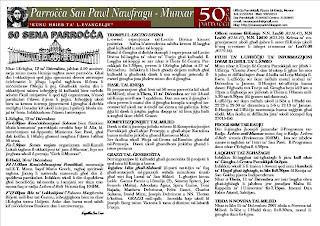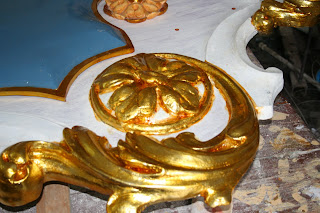Il-ġranet tal-Milied huma dejjem ġranet impenjattivi ħafna, imma għalina l-poplu tal-Munxar, dan l-aħħar Milied, minbarra l-attivitajiet tas-soltu, miegħu kien hemm marbuta l-attivitajiet tal-50 sena parroċċa li jaħbat eżattament fit-12 ta' Diċembru. Tajjeb għalhekk li niftakkru kemm affarijiet ġraw dan l-aħħar, għax xi kultant tant nagħmlu affarijiet f'daqqa li lanqas nirrealizzaw kemm affarijiet irnexxilna nagħmlu flimkien minkejja ċ-ċċokon tar-raħal tagħna. Mela nibdew bl-ordni ta' kif ġraw l-affarijiet...
L-Erbgħa 12 ta' Diċembru

Huwa l-anniversarju ta' meta l-Munxar sar parroċċa, iġifieri komunita' parrokkjali bil-kappillan tagħha. Dan il-jum il-Kunsill Lokali għażlu wkoll bħala Jum il-Munxar. Dan kien jum fuq kollox ta' ringrazzjament lil Alla għal dak kollu li l-Mulej bl-interċessjoni ta' San Pawl Missierna għamel magħna. Għalhekk fis-6.00pm saret konċelebrazzjoni solenni mmexxija mill-Kappillan Dun Tonio Galea flimkien mas-saċerdoti tal-Parroċċa, kien hemm ukoll preżenti l-Arċipriet ta' Għajnsielem, Dun Frankie Bajada li kien l-aħħar Kappillan tal-Parroċċa tagħna. Għalhekk matul din iċ-ċelebrazzjoni kien hemm preżenti tlieta mill-erba' kappillani tal-Parroċċa l-aktar żagħżugħa. Żgur li anke l-ewwel kappillan, Dun Alan Fenech kien qiegħed irodd ħajr lil Alla magħna mis-sema. Fil-priedka tiegħu l-Kappillan Dun Tonio, għamel enfasi fuq x'inhi l-parroċċa, u qal li l-parroċċa fuq kollox hija komunita' ta' nies li flimkien jisimgħu u jiċċelebraw il-Kelma ta' Alla u l-Ewkaristija u mbagħad jgħixuha fil-ħajja tagħhom ta' kuljum. Fl-aħħar tal-quddiesa ġiet moqrija poeżija li nkitbet minn Mons. Jose Agius, iben il-parroċċa li qiegħed fil-Brażil, b'hekk anke Mons. Agius b'xi mod kien magħna f'din iċ-ċelebrazzjoni tant importanti u sinifikattiva.

Dritt wara ċ-ċelebrazzjoni ta' ringrazzjament il-poplu tal-Munxar inġabar fis-sala taċ-ċentru parrokkjali għal serata' organizzata mill-Kunsill Lokali fl-okkażżjoni ta' jum il-Munxar. Kienet serata' varjata fejn fija deheru diversi kapaċitajiet tat-tfal u ż-żgħażagħ tagħna, dan kien jinkludi, pittura, komponimenti kif ukoll drama. Kien hemm ukoll powerpoint presentation dwar kif il-knisja tal-Munxar saret parroċċa miktub minn Frances Mercieca. Il-Powerpoint kienet magħmula minn Isabel Said, ir-rittratti ħafna minnhom kienu ta' Paul Curmi, oħrajn antiki ħafna u jinsabu fl-arkivju tal-knisja kif ukoll għand diversi nies mill-komunita' parrokkjali tagħna. Il-qofol tas-serata' kien il-mument tal-għoti ta' "Ġieħ il-Munxar", li din is-sena fl-okkażżjoni tal-50 sena parroċċa ġie mogħti lil erba' minn nies li ġew nominati u li f'dawn il-50 sena ħadmu u għadhom jagħtu s-sehem taħghom fil-komunita' parrokkjali tagħna. Dawn kienu Mons. Ġużepp Curmi, Mons. Salv Debrincat, is-Sur Feliċ Debrincat u s-Sur Salvinu Mercieca. Nifirħulhom u j'Alla ż-żgħażagħ tagħna jieħdu l-eżempju ta' dawn in-nies li ddedikaw ħajjithom għall-parroċċa tagħna.
Il-Ħadd 16 ta' Diċembru

Il-Ħadd, Jum il-Mulej, kien imiss li aħna bħala komunita' parrokkjali ningħaqdu mar-Ragħaj Spiritwali tagħna, Mons. Isqof, Mario Grech, biex flimkien miegħu nroddu ħajr lil Alla għal dak li għamel magħna f'dawn l-aħħar 50 sena. Għalhekk fil-11.00am saret quddiesa pontifikali mmexxija minn Mons. Isqof flimkien mal-Kappillan, il-kleru tal-Parroċċa, preżenti kienu wkoll Dun Frankie Bajada, Arċipriet ta' Għajnsielem u ex-kappillan tal-parroċċa tagħna kif ukoll oħtu Ms. Doris Bajada li meta kien Kappillan dun Frankie kienet membru ħaj tal-komunita' parrokkjali tagħna. Kien hemm ukoll preżenti l-Arċipriet ta' Sannat Dun Tarċisju Camilleri. Mons. Isqof fl-omelija tiegħu għamel enfasi fuq kemm il-parroċċa għandha tħossa parti mid-djoċesi u minn naħa l-oħra anke d-djoċesi għandha tifraħ f'dan il-jum bil-komunita' parrokkjali tal-Munxar. Għalhekk il-parroċċa tkun ħajja daqs kemm tkun kapaċi tinfetaħ għall-oħrajn. Mons. Isqof għamel ukoll enfasi biex il-komunita' parrokkjali tkompli tikoopera mas-sejħa li l-kappillan għamel għal Lectio Divina, għax il-komunita tkun f'saħħita daqs kemm tisma' l-Kelma ta' Alla u tiċċelebra l-Ewkaristija.

Kif kien jixraq f'okkażjoni bħal din, f'12.00pm kull min xtaq morna nieklu flimkien bħala komunita' parrokkjali. Anke dan kien mument sabiħ ħafna, fejn bħala familja waħda, ferħana bil-birthday ta' xi ħadd partikulkari fraħna flimkien.
Il-Ħadd 23 ta' Diċembru

Jum il-concert tal-Milied imtella' mit-tfal tad-duttrina u l-katekist. Anke din kienet ġurnata impenjattiva u kienet tfisser ukoll ħafna xogħol li sar fil-ġranet ta' qabel. Il-concert huwa mument fejn it-tfal kollha li jattendu għad-duttrina fiċ-Ċentru Parrokkjali kellhom l-okkażjoni li jaħdmu bħala grupp u jtellgħu xi item żgħir fuq il-palk. Meta l-ġenituri u n-nanniet jaraw it-tfal u n-npputijiet tagħhom fuq il-plak, galihom ikun qisu qed jaraw lil akbar artisti u din hija xi ħaġa ta' min ifaħħara għax inkunu qed nagħmlu kuraġġ lil uliedna biex jużaw it-talenti tagħhom. Ovvjament fl-aħħar tas-serata', wara li t-tfal kollha taw is-sehem tagħhom, ma tistax tonqos il-farsa mtella minn Alfred Grech flimkien ma xi membri tal-Legion.
It-Tnejn 24 ta' Duċembru

Il-lejl l-aktar mistenni ta' dawn il-festi, l-lejl li fih niċċelebraw it-twelied ta' Sidna Ġesu Kristu. Ovvjament din ukoll kienet ġurnata impenjattiva ħafna, pero' bis-sehem ta' ħafna nies ix-xogħol ma jkunx daqshekk tqil. Fl-10.30pm inġbarna lkoll fiċ-Ċentru Parrokkjali sabiex nagħmlu l-purċissjoni tal-bambin, wirt li ħallilna l-qaddis Malti, San Ġorġ Preca. Din is-sena ippruvajna nagħtu spinta lil din il-purċissjoni billi ninvolvu aktar lit-tfal tad-duttrina, minbarra l-bambin u xi fanali kien hemm ukoll xi tfal lebsin ta' Rgħajja, anġli u slaten maġi. Il-Purċissjoni kienet organizzata mill-Kan. Dun Karm Curmi flimkien mal-katekisti tal-parroċċa. Waqt il-purċissjoni kulħadd seta' jinnota kemm kien hemm tiżjin sabiħ fit-twieqi u l-biebin tad-djar tagħna. Din hija xi ħaġa ta' min ifaħħarha ħafna.
Ta' min isemmi wkoll it-tiżjin li sar mill-fergħa ta' l-armar fil-pjazza tal-knisja u fil-pjazzetta ta' Dar Parrokkjali, anke dan ikompli jgħin biex fi żmien il-Milied ikun hawn ambjent sabiħ fil-Munxar. Dan ma sarx mingħajr sagrifiċċju, għax fil-kesħa li għamlet dan l-aħħar ħadd ma jieħu gost jogħqod fil-pjazza tal-Munxar jarma d-dwal, jitfi, jixgħel kif ukoll jirranġa l-ħsara li ssir minn ġurnata għal oħra. Grazzi mill-qalb lil dawk li għamlu dan ix-xogħol.

Il-Prurċissjoni spiċċat billi lkoll dħalna fil-knisja u hemmhekk segwejna programm qasir li fost l-oħrajn fakkarna fir-rakkont tat-twelied ta' Ġesu, permez ta' qari, kant, u anke d-dehra ta' xi personaġġi. Inqraw jew aħjar ġew ireċtati diversi poeżiji mit-tfal tagħna. Pero' fil-lejl tal-Milied l-aktar ħaġa li kulħadd ikun jistenna hija l-priedka tat-tifel. Din is-sena x-xorti messet lit-tfajjel Matthew Parnis li ħaqqu verament prosit għax mhux biss tgħallem il-priedka imma anke l-mod kif irrakkonta kien jidher li kie npreparat tajjeb ħafna.

Hekk kif l-arloġġ immarka nofs il-lejl bdiet il-quddiesa b'purċissjoni qasira, fejn il-kappillan akkumpanjat mis-saċerdoti u l-abbatini poġġa l-bambin tal-Milied f'post ippreparat għalih quddiem l-artal mejda għal qima tan-nies. Wara l-kant tal-glorja flimkien mad-daqq tal-qniepen u l-qari tal-Kelma ta' Alla, l-kappillan għamel omelija qasira ħafna, b'riferiment għat-tema tan-Novena: "Ħafna kliem... biex ngħidu l-KELMA", priedka qasira proprju għax issa għadda ż-żmien tal-"ħafna kliem" u wasal l-mument tal-"KELMA" li huwa dak li għalih qed nagħmlu l-festa. Għalhekk wara li reġa fakkar din it-tema, l-kappillan stieden lin-nies sabiex filwaqt li kien ser jintefa' d-dawl kollhu tal-Knisja minbarra d-dawl fuq Ġesu Bambin, iħallu lilHU jkellimhom. Kien mument sabiħ ħafna, kien hemm skiet kbir u tinduna li kien verament mument ta' talb.
Wara l-quddiesa ħafna waqfu fuq iz-zuntier biex jgħatu l-awguri lil xulxin, l-awguri komplew fil-bar taċ-ċentru fejn kulħadd kien mistieden għal ftit cafe' u te flimkien. Anke dan kien mument sabiħ li temm ġurnata oħra impenjattiva mma mill-isbaħ.
Kif għidt fil-bidu ta' dan l-artiklu xi kultant aħna stess ma nindunawx kemm inkunu għamilna affraijiet u għalhekk li nkiteb dan l-artiklu biex nindunaw x'potenzjal għandna fir-raħal tagħna u napprezzaw l-isforzi li jsiru. Grazzi mill-qalb lil dawk kollha li b'xi mod taw is-sehem tagħhom f'dawn il-festi tal-50 sena kif ukoll tal-Milied. Grazzi wkoll lil dawk kollha li pparteċipaw għax mingħajr il-parteċipazzjoni tagħkom għalxejn jiġu organizzati attivitajiet. Grazzi u l-kumplament tal-Festi t-tajba.
Ara r-rittratti kollha ta' dawn l-attivitajiet fuq: http://picasaweb.google.it/munxarparish









































